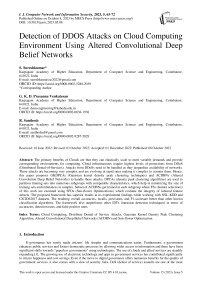Detection of DDOS Attacks on Cloud Computing Environment Using Altered Convolutional Deep Belief Networks
Автор: S. Sureshkumar, G.K.D. Prasanna Venkatesan, R. Santhosh
Журнал: International Journal of Computer Network and Information Security @ijcnis
Статья в выпуске: 5 vol.15, 2023 года.
Бесплатный доступ
The primary benefits of Clouds are that they can elastically scale to meet variable demands and provide corresponding environments for computing. Cloud infrastructures require highest levels of protections from DDoS (Distributed Denial-of-Services). Attacks from DDoSs need to be handled as they jeopardize availability of networks. These attacks are becoming very complex and are evolving at rapid rates making it complex to counter them. Hence, this paper proposes GKDPCAs (Gaussian kernel density peak clustering techniques) and ACDBNs (Altered Convolution Deep Belief Networks) to handle these attacks. DPCAs (density peak clustering algorithms) are used to partition training sets into numerous subgroups with comparable characteristics, which help in minimizing the size of training sets and imbalances in samples. Subset of ACDBNs get trained in each subgroup where FSs (feature selections) of this work are executed using SFOs (Sun-flower Optimizations) which evaluate the integrity of reduced feature subsets. The proposed framework has superior results in its experimental findings while working with NSL-KDD and CICIDS2017 datasets. The resulting overall accuracies, recalls, precisions, and F1-scoresare better than other known classification algorithms. The framework also outperforms other IDTs (intrusion detection techniques) in terms of accuracies, detection rates, and false positive rates.
Cloud Computing, Distribute Denial of Service Attacks, Gaussian Kernel Density Peak Clustering Algorithm, Altered Convolutional Deep Belief Networks (ACDBN) and Sun-flower Optimization
Короткий адрес: https://sciup.org/15018645
IDR: 15018645 | DOI: 10.5815/ijcnis.2023.05.06
Список литературы Detection of DDOS Attacks on Cloud Computing Environment Using Altered Convolutional Deep Belief Networks
- Kumar, A., & Sharma, A. (2016). Paradigm shifts from e-governance to s-governance. The human element of big data: issues, analytics, and performance, 213.
- Shaar, F., &Efe, A. (2018). DDoS attacks and impacts on various cloud computing components. International Journal of Information Security Science, 7(1).
- Mell, P., &Grance, T. (2011). The NIST definition of cloud computing. NIST special publication, vol. 800, no. 145, p. 7, 2011.
- Alarqan, M. A., Zaaba, Z. F., &Almomani, A. (2019, July). Detection mechanisms of DDoS attack in cloud computing environment: A survey. In International Conference on Advances in Cyber Security (pp. 138-152). Springer, Singapore.
- Bhardwaj, A., Mangat, V., &Vig, R. (2020). Hyperband Tuned deep neural network with well posed stacked sparse AutoEncoder for detection of DDoS attacks in cloud. IEEE Access, 8, 181916-181929.
- Kasim, Ö. (2020). An efficient and robust deep learning based network anomaly detection against distributed denial of service attacks. Computer Networks, 180, 107390.
- Çakmakçı, S. D., Kemmerich, T., Ahmed, T., & Baykal, N. (2020). Online DDoS attack detection using Mahalanobis distance and Kernel-based learning algorithm. Journal of Network and Computer Applications, 168, 102756.
- Kushwah, G. S., &Ranga, V. (2021). Optimized extreme learning machine for detecting DDoS attacks in cloud computing. Computers & Security, 105, 102260.
- Kushwah, G. S., &Ranga, V. (2022). Detecting DDoS Attacks in Cloud Computing Using Extreme Learning Machine and Adaptive Differential Evolution. Wireless Personal Communications, 1-24.
- Verma, P., Tapaswi, S., & Godfrey, W. W. (2020). An adaptive threshold-based attribute selection to classify requests under DDoS attack in cloud-based systems. Arabian Journal for Science and Engineering, 45(4), 2813-2834.
- Amma, N. G., &Selvakumar, S. (2021). Optimization of vector convolutional deep neural network using binary real cumulative incarnation for detection of distributed denial of service attacks. Neural Computing and Applications, 1-14.
- Bhardwaj, A., Mangat, V., &Vig, R. (2020). Hyperband Tuned deep neural network with well posed stacked sparse AutoEncoder for detection of DDoS attacks in cloud. IEEE Access, 8, 181916-181929.
- Gomes GF, da Cunha SS, Ancelotti AC (2018) A sunfower optimization (SFO) algorithm applied to damage identifcation on laminated composite plates. EngComput 2018:1–8
- Lee, H., Grosse, R., Ranganath, R., & Ng, A. Y. (2011). Unsupervised learning of hierarchical representations with convolutional deep belief networks. Communications of the ACM, 54(10), 95-103.
- Hinton, Geoffrey E. "Deep Belief Nets." (2010): 267-269.
- Bhardwaj, A., Mangat, V., &Vig, R. (2020). Hyperband Tuned deep neural network with well posed stacked sparse AutoEncoder for detection of DDoS attacks in cloud. IEEE Access, 8, 181916-181929.
- Atika Bansal, Divya Kapil, Anupriya, Sagar Agarwal, Vishan Kumar Gupta, " Analysis and Detection of various DDoS attacks on Internet of Things Network", International Journal of Wireless and Microwave Technologies, Vol.12, No.3, pp. 18-32, 2022.
- T. Raja Sree, S. Mary Saira Bhanu," Investigation of Application Layer DDoS Attacks Using Clustering Techniques", International Journal of Wireless and Microwave Technologies, Vol.8, No.3, pp. 1-13, 2018.
- Kaushik Sekaran, G.Raja Vikram, B.V. Chowdary, "Design of Effective Security Architecture for Mobile Cloud Computing to Prevent DDoS Attacks ", International Journal of Wireless and Microwave Technologies, Vol.9, No.1, pp. 43-51, 2019.


